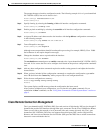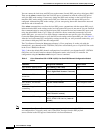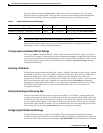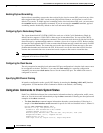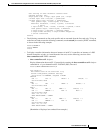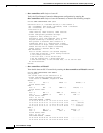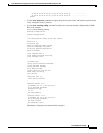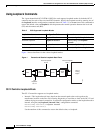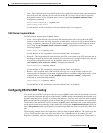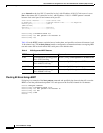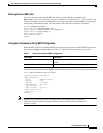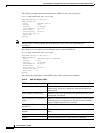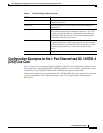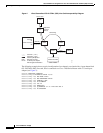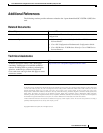
Cisco IOS Software Configuration for the 1-Port Channelized OC-12/STM-4 (DS3) Line Card
How to Configure the 1-Port Channelized OC-12/STM-4 (DS3) Line Card
13
Cisco IOS Release 12.0(8)S
• Line—This loopback mode loops data from the receive path to the transmit path at the mux/demux
part on the line card, returning all received data at the OC-12 level to the far end. In controller
configuration mode, set the loopback mode to line, using the [no] loopback [internal | line]
configuration command:
Router(config-controller)# loopback line
Router(config-controller)#
Use the no form of this command to restore the default value to no loopback.
DS3 Channel Loopback Mode
The DS3 channel supports three loopback modes:
• Local—This loopback mode loops data from the transmit path to the receive path at the QJET
location on the line card, allowing diagnostics to send data to itself over a single channel without
relying on external connections. In serial interface configuration mode, set the loopback mode to
local, using the [no] loopback [local | network | remote ] configuration command, as in the
following example:
Router(config-if)# loopback local
Use the no form of this command to restore the default value, no loopback.
• Network—This loopback mode loops data from the STS1 receive path to the STS1 transmit path at
the Mapper location on the line card, returning all received data over a single channel to the far end.
In controller configuration mode, set the loopback mode to local, using the
[no] loopback [local | network | remote ] configuration command:
Router(config-if)# loopback network
Use the no form of this command to restore the default value, no loopback.
• Remote—This loopback mode sends an FEAC message over a single channel to the far end,
requesting that it transition into network loopback mode. In controller configuration mode, set the
loopback mode to local, using the [no] loopback [local | network | remote ] configuration
command, as in the following example:
Router(config-if)# loopback remote
Use the no form of this command to restore the default value, no loopback.
Configuring DS3 Port BER Testing
You can set one local DS3 serial port to bit error rate test (BERT) mode while the remaining local serial
ports continue to transmit and receive normal traffic. A BERT checks communication between the local
and the remote DS3 ports. If traffic is not being transmitted or received, create a back-to-back loopback
BER test and send out a predictable stream to ensure that you receive the same data that was transmitted.
To determine if the remote DS3 serial port returns the BERT pattern unchanged, the system administrator
for the remote router must manually set the remote DS3 serial port to loopback network line, while you
enter a bert pattern interface configuration command at specified time intervals on the local DS3 serial
port.
The following example shows the output from a back-to-back loopback BER test. The router types are
a Cisco 12012 Router on the local (near) end, and a Cisco 12008 Router on the remote (far) end.
Keepalive is disabled, while the loopback network line test runs between both routers. Clock source is



